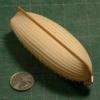-
Posts
13,301 -
Joined
-
Last visited
Content Type
Profiles
Forums
Gallery
Events
Everything posted by druxey
-
Brilliant work as usual, Doris. I'm sorry that pictures of your work have been pirated as someone else's. While imitation is the sincerest form of flattery, it is really annoying that an inferior product is being marketed using your images. Perhaps add a watermark on your pictures as well? An unscrupulous person could easily remove your copyright sign and name using Photoshop! It's a shame that there are those sorts of people out there.
- 1,035 replies
-
- royal katherine
- ship of the line
-
(and 1 more)
Tagged with:
-
Your reconstruction is logical and mechanically sound, Dick. I'd buy it!
- 263 replies
-
- nave tonda
- round ship
-
(and 2 more)
Tagged with:
-
The drawing above is accurate - to a point. While the outhaul correctly shows a double/single block arrangement, that was only used for guns of larger calibre. Smaller ones were rigged single/single. The breeching is shown secured to the ringbolts using seizings. This was correct for the early 18th century. However - about mid-century I think - the ends were half-hitched and secured by a single seizing instead.
-
Thanks, Maury. It looks (from the angle of the photo), that the first band of planking above the garboard might have to taper too much as it reaches the bow rabbet. Hopefully that isn't the case! Also, that an angle might appear forward of the third strake away from the garboard.
-
Glad the new scheme is working out, Maury! Perhaps move the threads up slightly at the bow as shown?
-
You are producing a silk purse from a sow's ear, George! (It's an old English expression.)
- 90 replies
-
- bomb ketch
- pyro
-
(and 1 more)
Tagged with:
-
Ah, project creep and no remuneration creep to accompany it....
- 133 replies
-
- alert class
- tugboat
-
(and 1 more)
Tagged with:
-
Depends on the kind of lighting you want, Richmond.
-

Le Soleil Royal by Nek0 - 1/72 - Marc Yeu
druxey replied to Nek0's topic in - Build logs for subjects built 1501 - 1750
Just stumbled across this thread. Very, very impressive work, beautifully executed. When is the next instalment, I wonder....- 208 replies
-
- le soleil royal
- 104 guns
-
(and 2 more)
Tagged with:
-
Unfortunately talk of mutiny makes me think of the film Battleship Potemkin by Eisenstein.
About us
Modelshipworld - Advancing Ship Modeling through Research
SSL Secured
Your security is important for us so this Website is SSL-Secured
NRG Mailing Address
Nautical Research Guild
237 South Lincoln Street
Westmont IL, 60559-1917
Model Ship World ® and the MSW logo are Registered Trademarks, and belong to the Nautical Research Guild (United States Patent and Trademark Office: No. 6,929,264 & No. 6,929,274, registered Dec. 20, 2022)
Helpful Links
About the NRG
If you enjoy building ship models that are historically accurate as well as beautiful, then The Nautical Research Guild (NRG) is just right for you.
The Guild is a non-profit educational organization whose mission is to “Advance Ship Modeling Through Research”. We provide support to our members in their efforts to raise the quality of their model ships.
The Nautical Research Guild has published our world-renowned quarterly magazine, The Nautical Research Journal, since 1955. The pages of the Journal are full of articles by accomplished ship modelers who show you how they create those exquisite details on their models, and by maritime historians who show you the correct details to build. The Journal is available in both print and digital editions. Go to the NRG web site (www.thenrg.org) to download a complimentary digital copy of the Journal. The NRG also publishes plan sets, books and compilations of back issues of the Journal and the former Ships in Scale and Model Ship Builder magazines.



